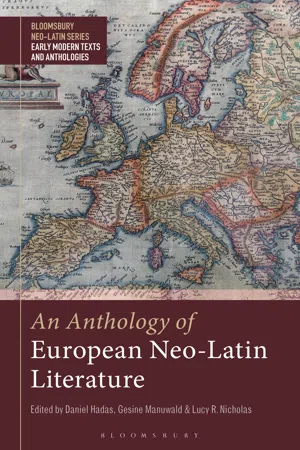
An Anthology of European Neo-Latin Literature
- 328 pages
- English
- ePUB (mobile friendly)
- Available on iOS & Android
An Anthology of European Neo-Latin Literature
About this book
Compiled by a team of international experts, this volume showcases the best of the huge abundance of literature written in Latin in Europe from about 1500 to 1800. A general introduction provides readers with the context they need before diving into the 19 high-quality short Latin extracts and English translations. Together these texts present a rich panorama of the different literary genres, styles and themes that flourished at the time, and include authors such as Erasmus, Buchanan, Leibniz and Newton, along with less well-known writers. From the vast array of material available, a varied and meaningful sample of texts has been carefully curated by the editors of the volume. Passages not only exhibit literary merit or historical importance, but also illustrate the role of the complete texts from which they have been selected in the development of Neo-Latin literature. They reflect the wide range of authors writing in Latin in early modern Europe, as well as the importance of Latin in the history of ideas. As with all volumes in the series, section introductions and accompanying notes on every text provide orientation on the material for students.
Frequently asked questions
- Essential is ideal for learners and professionals who enjoy exploring a wide range of subjects. Access the Essential Library with 800,000+ trusted titles and best-sellers across business, personal growth, and the humanities. Includes unlimited reading time and Standard Read Aloud voice.
- Complete: Perfect for advanced learners and researchers needing full, unrestricted access. Unlock 1.4M+ books across hundreds of subjects, including academic and specialized titles. The Complete Plan also includes advanced features like Premium Read Aloud and Research Assistant.
Please note we cannot support devices running on iOS 13 and Android 7 or earlier. Learn more about using the app.
Information
1
A Pastoral Exchange on the Treatment of Poets
Battista Spagnoli Mantovano (1447–1516), Adolescentia 5.1–23, 68–91, 111–25
Introduction
Table of contents
- Cover
- Half-Title Page
- Series Page
- Title Page
- Contents
- List of Contributors
- Preface
- Introduction
- 1 A Pastoral Exchange on the Treatment of Poets
- 2 The Pierced Ear: Divine Revelation and Impregnation
- 3 The Abbot and the Learned Woman
- 4 Christopher Columbus’ First Voyage
- 5 Morbid Measures and Contaminated Airs: The Poetics of Pox
- 6 A Protestant on the Attack in Latin
- 7 Greeting Charles V at Bordeaux, 1539
- 8 Epistolae Obscurorum Virorum (1515–19)
- 9 The Pleasures of the Hills
- 10 Neo-Latin Love Elegy
- 11 A Jesuit Encounter with an Indian Yogi
- 12 Mary, Liturgy and Missions
- 13 Seneca’s Death Dramatized
- 14 Virgilian Commentary
- 15 Vitalist Philosophy from a Long-lost Author
- 16 A New Approach to Studying Old Documents
- 17 Newton on Theology
- 18 Damnation and Divine Justice
- 19 A School Play
- Index of Names
- Copyright